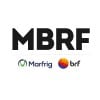
MBRF
We are one of the leading global producers and exporters of quality food, as we believe it is fundamental to a better life for all people. Not only what we do, but the way we do it, is guided by the purpose of a better life for everyone, from farm to fork. That is why we conduct a sustainable management of our chain, which is vivid, long and complex. In our chain, it is vital to know how to manage interdependence, appreciate knowledge and the development of people and their diversity, ensure efficiency and always innovate. That is how we guarantee our results. We never relinquish Safety, Quality and Integrity to reach our goals and, guided by these fundamental commitments, we maintain operations in more than 127 countries, we are responsible for iconic and beloved brands such as Sadia, Perdigão and Qualy, and own over 35 production plants, 40 distribution plants, in addition to more than 4,000 products and 4.5 million tons of food sold around the globe. Producing food in a way that improves the lives of so many people worldwide is a fascinating challenge. This is our greatest passion.






